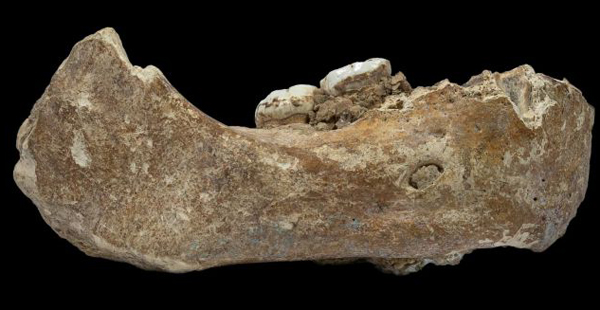Jaw Fossil Indicates Denisovans Occupied the Tibetan Plateau
Denisovans, occupied the Tibetan Plateau long before Homo sapiens arrived in the region. Furthermore, the ability to cope with less oxygen at high altitudes may have been passed onto our species when ancient members of Homo sapiens, bred with Denisovans. The analysis of a fragmentary lower jaw bone reveals the presence of Denisovans at least 160,000 years ago at the Baishiya Karst Cave complex in Xiahe, China.
The ability to survive in such extreme climates had been thought to be a unique trait of H. sapiens, that is now not the case and what is more, the enigmatic and poorly known Denisovans seem to have passed on a gene that helps modern people cope with living at high elevations.
A Digital Reconstruction of the Fossil Mandible

Picture credit: Jean-Jacques Hublin (MPI-EVA)
The Enigmatic Denisovan People
The study, undertaken by a team of international researchers including Shara Bailey (New York University), as well as scientists from the Institute of Tibetan Plateau Research, the Chinese Academy of Sciences, Lanzhou University, and the Max Planck Institute for Evolutionary Anthropology, has been published in the journal “Nature”.
Using a technique known as ancient protein analysis, the researchers found that the mandible’s (lower jaw) owner belonged to a Denisovan population from Siberia. This population occupied the Tibetan Plateau, regarded as the “Roof of the World” because it rises three miles (five kilometres), above sea level. This suggests that the enigmatic Denisovans were adapted to a low oxygen environment.
In contrast, evidence of Neanderthals is rarely found above 2,000 metres and what evidence there is, probably indicates that Homo neanderthalensis populations only occasionally climbed to such heights, perhaps for the purpose of a special hunt or ceremony. They do not seem to have persisted at high altitude.
The research team state that Denisovans had already adapted to living in this high-altitude setting significantly prior to the appearance of Homo sapiens. Previous genetic studies found present-day Himalayan populations carry the EPAS1 allele in their genome, passed on to them by Denisovans, which helps with adaptation to their specific and demanding environment.
A Posterior View of the Fossil Mandible
Picture credit: Jean-Jacques Hublin (MPI-EVA)
Who Were the Denisovans?
Denisovans are members of a hominin group currently only known directly from fragmentary fossils, the genomes of which have been studied from a single site, Denisova Cave in Siberia. They are also known indirectly from their genetic legacy through gene flow into several low-altitude East Asian populations and high-altitude modern Tibetans. The presence of a new species of ancient human was confirmed when a research team led by Svante Pääbo from the Max Planck Institute for Evolutionary Anthropology (MPI-EVA), conducted a genetic study on a single fossil finger bone from the Denisova Cave site.
To read an article from 2010 that summarises the Max Planck Institute for Evolutionary Anthropology research: Finger Bone Hints at New Species of Hominin.
Commenting on the significance of linking a fossil to the Tibetan Plateau, one of the paper’s co-authors Jean-Jacques Hublin (MPI-EVA), stated:
“Traces of Denisovan DNA are found in present-day Asian, Australian, and Melanesian populations, suggesting that these ancient hominins may have once been widespread. Yet, so far, the only fossils representing this ancient hominin group were identified at the Denisova Cave.”
Indeed, Everything Dinosaur published a report back in 2016 that linked the Inuit people of the Arctic to a Denisovan ancestry: Extinct Human Cousin Helped the Inuit Survive.
A Photograph of the Actual Fossil Jaw Bone (Lateral View)
Picture credit: Dongju Zhang (Lanzhou University)
Discovered by a Monk
In this newly published paper, the researchers describe a hominin lower mandible that was found on the Tibetan Plateau in the Baishiya Karst Cave in Xiahe, Gansu Province, China. The fossil was originally discovered in 1980 by a local monk who donated it to the 6th Gung-Thang Living Buddha who then passed it on to Lanzhou University.
Since 2010, researchers Fahu Chen and Dongju Zhang from Lanzhou University have been studying the cave site from where the mandible originated in a bid to find more human remains. In 2016, a collaboration began with the Department of Human Evolution at the Max Planck Institute for Evolutionary Anthropology and although no DNA has been recovered, the team did manage to extract proteins from one of the large molars within the jaw. These proteins were then categorised using a technique called ancient protein analysis.
The Reconstructed Denisovan Jaw Bone
Picture credit: Jean-Jacques Hublin (MPI-EVA)
Piecing Together the Face of a Denisovan
The fossil record of the Denisovans is particularly sparse, it is limited to just some teeth and part of a finger. This is the first fossil of its kind to be found and perhaps, if more Denisovan fossils can be discovered, then it hints at the possibility that anthropologists might be able to reconstruct the skull.
Co-author Shara Bailey explained:
“Although we still do not know the shape and size of the Denisovan skull, now with a lower jaw we can start to piece together the puzzle of what they actually looked like”.
Everything Dinosaur acknowledges the assistance of a press release from New York University in the compilation of this article.
Visit the Everything Dinosaur website: Everything Dinosaur.









Leave A Comment